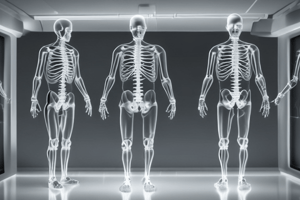Podcast
Questions and Answers
What is radiography primarily used for in medicine?
What is radiography primarily used for in medicine?
Diagnostic purposes, allowing visualization of bones, organs, and tissues.
Name two types of radiography that utilize X-rays.
Name two types of radiography that utilize X-rays.
Conventional Radiography and Fluoroscopy.
What is the key difference between Computed Radiography (CR) and Digital Radiography (DR)?
What is the key difference between Computed Radiography (CR) and Digital Radiography (DR)?
CR uses imaging plates for digital imaging, while DR directly captures images using electronic sensors.
What does the ALARA principle stand for in the context of radiography?
What does the ALARA principle stand for in the context of radiography?
Who are radiologic technologists and what is their role?
Who are radiologic technologists and what is their role?
What are some advantages of radiography?
What are some advantages of radiography?
Mention one significant limitation of radiography.
Mention one significant limitation of radiography.
What future trends are expected to enhance radiography?
What future trends are expected to enhance radiography?
Flashcards are hidden until you start studying
Study Notes
Overview of Radiography
- Definition: Radiography is the use of ionizing radiation to produce images of the internal structures of an object, typically the human body.
- Purpose: Primarily used for diagnostic purposes in medicine, allowing visualization of bones, organs, and tissues.
Types of Radiography
-
Conventional Radiography
- Uses X-rays to produce static images.
- Commonly used for bone fractures, chest X-rays, and dental imaging.
-
Computed Radiography (CR)
- Digital imaging using imaging plates.
- Offers quicker processing compared to traditional methods.
-
Digital Radiography (DR)
- Direct capture of images using electronic sensors.
- Provides instant images with better quality and lower radiation doses.
-
Fluoroscopy
- Real-time imaging using a continuous X-ray beam.
- Often used for observing the gastrointestinal tract and guiding certain procedures.
-
Mammography
- Specialized radiography for breast tissue imaging.
- Essential for early detection of breast cancer.
Principles of Radiography
-
Radiation Types:
- X-rays; gamma rays (both ionizing).
-
Image Formation:
- X-rays pass through the body and are absorbed by dense tissues (like bones) appearing white on the image, while less dense tissues (like muscles) appear darker.
-
Radiation Safety:
- Minimize exposure: use protective gear (lead aprons), appropriate shielding, and follow ALARA principle (As Low As Reasonably Achievable).
Roles in Healthcare
- Radiologic Technologists: Professionals who perform radiography exams and ensure patient safety and comfort.
- Radiologists: Physicians who interpret radiographic images and diagnose conditions based on findings.
Advantages of Radiography
- Non-invasive method for diagnosis.
- Provides quick results.
- Ability to image a wide range of conditions.
Limitations and Risks
- Exposure to ionizing radiation may pose health risks.
- Potential for misinterpretation of images, requiring skilled personnel for accurate readings.
- Not suitable for pregnant patients without careful consideration.
Future Trends
- Advancements in AI for image analysis enhancement.
- Improved imaging techniques and equipment with lower radiation doses.
- Integration of radiography with other imaging modalities for comprehensive diagnostics.
Radiography Overview
- Radiography uses ionizing radiation, like X-rays and gamma rays, to create images of internal structures.
- Primarily used in medicine for diagnosis, visualizing bones, organs, and tissues.
Radiography Types
- Conventional Radiography: Utilizes X-rays to produce static images. Common uses include bone fracture detection, chest X-rays, and dental imaging.
- Computed Radiography (CR): Employs imaging plates for digital imaging, offering faster processing than traditional methods.
- Digital Radiography (DR): Directly captures images using electronic sensors, enabling instant image production with enhanced quality and reduced radiation exposure.
- Fluoroscopy: Provides real-time imaging using a continuous X-ray beam, typically used for observing the gastrointestinal tract and guiding procedures.
- Mammography: Specialized radiography for breast tissue imaging, crucial for early breast cancer detection.
Principles of Radiography
- Radiation Types: X-rays and gamma rays, both are ionizing.
- Image Formation: Tissues that absorb more X-rays, like bones, appear white on the image, while less dense tissues, like muscles, appear darker.
- Radiation Safety: Minimize exposure by using protective gear, shielding, and adhering to the ALARA principle (As Low As Reasonably Achievable).
Roles in Healthcare
- Radiologic Technologists: Perform radiography exams, ensuring patient safety and comfort.
- Radiologists: Physicians specializing in interpreting radiographic images and diagnosing conditions based on findings.
Advantages of Radiography
- Non-invasive diagnostic method.
- Provides quick results.
- Capable of imaging a wide range of conditions.
Limitations and Risks
- Ionizing radiation exposure carries potential health risks.
- Images can be misinterpreted, requiring skilled personnel for accurate interpretation.
- Not suitable for pregnant patients without careful consideration.
Future Trends
- Advancement in Artificial Intelligence (AI) for image analysis enhancement.
- Improved imaging techniques and equipment with reduced radiation doses.
- Integration of radiography with other imaging modalities for comprehensive diagnostics.
Studying That Suits You
Use AI to generate personalized quizzes and flashcards to suit your learning preferences.




